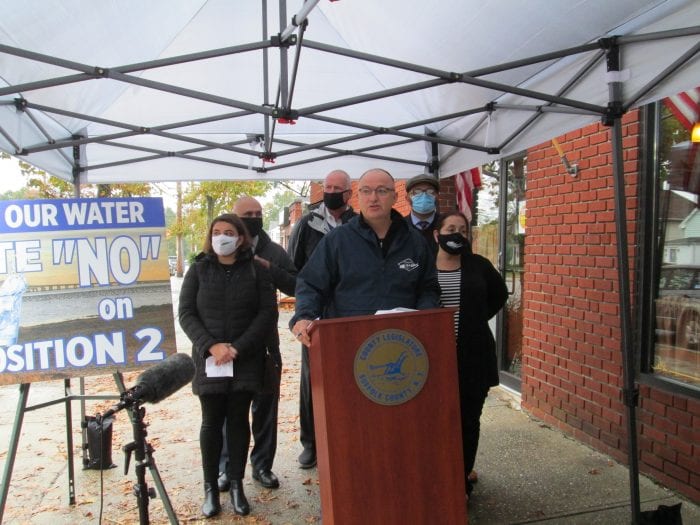Smithtown town officials presented its 2021 tentative budget of $107.6 million to residents last week during a virtual public town hall meeting. A budget vote is scheduled for November.
“2020 has certainly been a whirlwind throwing challenges our way that are expected to continue throughout 2021,” Town Supervisor Ed Wehrheim (R) said during the meeting. “It has made our jobs as municipal managers much more difficult in both overseeing the operating results for 2020 and projecting the budget for 2021.”
He said that early on in the pandemic, the town “weathered the storm” and created adequate reserves to keep things intact and continued to complete advantageous projects including the Lake Avenue Business District, among others. “The economic benefits of these projects will last long into the future, allowing for generations to come benefit greatly,” he said.
Wehrheim added that this year the town decreased overtime and decided to cut discretionary spending by 15%.
“If we should experience this again, we can promise you that town board, myself and our town employees will be ready after all the town endures.”
— Ed Wehrheim
The upcoming budget claims it will maintain municipal services while trimming payroll and increasing property taxes on the typical non-village home less than 1%.
“In 2020, we looked to reducing expenditures by reinventing our own ways of doing business and created new opportunities to make up for the pandemic-related shortfall,” the supervisor said. “This enabled me to deliver a budget it stays within a mandated allowable New York state tax cap limitation this year of 1.5%, which is becoming increasingly more difficult for municipal managers.”
Some highlights included an overall decrease in salaries accounting for a little over $600,000.
“Due to the retirement incentive we instituted during the pandemic, we did not utilize any fund balance to balance this budget,” he said. “It is a structurally balanced budget.”
Wehrheim said that overall taxes increased by less than 1% with the exception of residents within the St. James water district who experienced a slightly greater increase due to the water mains along Lake Avenue. The Lake Avenue Project cost $8 million, and includes a dry sewer line that officials home could connect to a sewage treatment plant at the Gyrodyne site near the town’s Brookhaven border.
The 2021 tentative budget meeting broke down expenses by type. The bulk of expenses at 34% goes towards salaries, 30% to contractual agreements, 29% to employee benefits, 5% to debt service and 2% to equipment.
It also states the Town’s General fund will see an increase of $22.57 for a home assessed at $5,500 or 3.74%. The same residence will see a reduction in their highway taxes of $4.51 or 3.61% for a net increase of $18.06 per residence valued at $5,500 or 2.48% increase.
Residents not within village boundaries will see taxes increase by $10.48 for a home assessed at $5,500 or 0.81% higher. Wehrheim said no use of fund balance in any of those funds were used to balance the budget.
After officials broke down the plan, residents voiced their concerns. Members from the civic group We Are Smithtown brought up issues surrounding the Lake Avenue Project, the Master Plan and questions involving the town’s School Age Child Care Program.
The group criticized that the budget seemed to show the town was profiting off of the program with the tentative budget showing revenue exceeded expenses by $548,264 in 2019. However, it shows that the program is expected to operate at a $226,846 loss this year, and that revenue is expected to exceed costs by $100,000 in 2021.
James Bouklas, president of the group, argued that the Town of Smithtown brings in $1.413 million in revenue for the program each year, yet the budget shows the program’s cost is $828,000 – a profit of almost $600,000 yearly.
“If you look at the cost, you can see it’s pretty comprehensive,” he said. “This is not its own fund, it’s part of the general fund … In my opinion, it’s pretty comprehensive. There’s not a lot of shared services.”
He added that the group called for an accounting for every dollar coming into the program. “All profits should be refunded to the families of the program,” Bouklas said.
Patty Stoddard, a Nesconset resident and board member of the group, said this program is essential to working parents and should be accounted for.
“This is a program that is a lifeline for working parents often work long hours to be able to afford to live in Smithtown and send their kids to excellence,” she said at the meeting. “This is not the first time we’ve addressed issues with this program. It came to our attention earlier this year that many childcare workers in the towns program were earning less than minimum wage. We pressured the town into doing the right thing and the town agreed to increase wages.”
However, Town Comptroller Donald Musgnug said the budget does not break down the program’s cost provided by other town departments including payroll, insurance, accounting and Parks and Recreation.
“If you add them to the direct costs, would greatly diminish what you’re perceiving to be, quote, a profit,” he said. “We don’t measure profit and losses within a governmental entity. We’re not viewing it as a business per say. We’re not trying to make money off of that, and the fact of the matter is between 2020, because of the diminished revenues, we’re anticipating a loss of $227,000.”
Despite the problems 2020 caused for everyone locally and across the country, Wehrheim said he hopes the town will never have to witness circumstances like this again.
“If we should experience this again, we can promise you that town board, myself and our town employees will be ready after all the town endures,” he said.











 George Francis Rice, Jr., Esq., a resident of Setauket for more than 40 years, passed away peacefully on Oct. 15 at the age of 75.
George Francis Rice, Jr., Esq., a resident of Setauket for more than 40 years, passed away peacefully on Oct. 15 at the age of 75.









